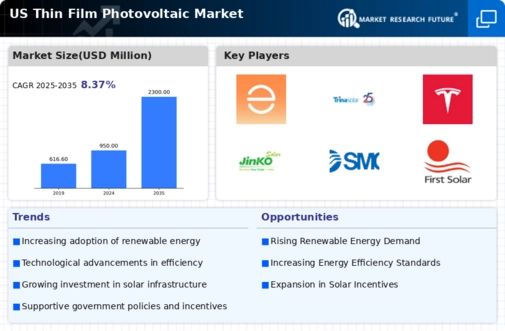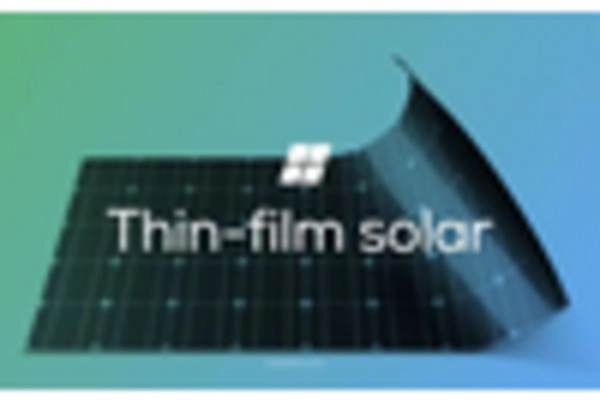Rising Environmental Awareness
Rising environmental awareness among consumers and businesses is a crucial driver for the thin film-photovoltaic market. As public consciousness regarding climate change and sustainability grows, there is a marked shift towards adopting cleaner energy solutions. In the US, surveys indicate that over 70% of consumers are willing to pay a premium for products that are environmentally friendly. This trend is influencing purchasing decisions, leading to increased interest in solar technologies, including thin film photovoltaics. The market is likely to benefit from this heightened awareness, as more individuals and organizations seek to reduce their carbon footprints and invest in renewable energy solutions.
Growing Demand for Renewable Energy
The increasing demand for renewable energy sources is a significant driver for the thin film-photovoltaic market. As concerns over climate change and energy security intensify, the US government and private sector are investing heavily in renewable energy technologies. In 2025, renewable energy sources account for about 20% of the total energy consumption in the US, with solar energy playing a pivotal role. The thin film-photovoltaic market is well-positioned to meet this demand due to its versatility and efficiency in various applications, including residential, commercial, and industrial sectors. This growing demand is expected to propel the market forward, as more stakeholders recognize the benefits of integrating thin film technologies into their energy portfolios.
Cost Efficiency of Thin Film Technology
The thin film-photovoltaic market benefits from the cost efficiency associated with its production processes. Thin film technologies, such as cadmium telluride (CdTe) and amorphous silicon (a-Si), typically require less material than traditional silicon-based solar cells. This reduction in material usage can lead to lower manufacturing costs, which is crucial in a competitive market. In the US, the average cost of solar energy has decreased by approximately 70% over the past decade, making solar solutions more accessible to consumers and businesses alike. As the thin film-photovoltaic market continues to evolve, the emphasis on cost efficiency is likely to drive adoption, particularly in utility-scale projects where economies of scale can be realized.
Innovations in Energy Storage Solutions
Innovations in energy storage solutions are likely to enhance the viability of the thin film-photovoltaic market. As solar energy generation is inherently intermittent, the development of advanced battery technologies and energy management systems can complement thin film systems by providing reliable energy supply. In the US, the energy storage market is projected to grow significantly, with estimates suggesting a compound annual growth rate (CAGR) of over 20% through 2030. This synergy between thin film photovoltaics and energy storage solutions may lead to increased adoption rates, as consumers and businesses seek to maximize the efficiency and reliability of their renewable energy systems.
Increased Investment in Solar Infrastructure
The thin film-photovoltaic market is experiencing a surge in investment aimed at enhancing solar infrastructure across the US. Federal and state governments are implementing various incentives and funding programs to support solar energy projects. In 2025, total investments in solar infrastructure are expected to exceed $100 billion, reflecting a strong commitment to expanding renewable energy capabilities. This influx of capital is likely to facilitate the development of new thin film technologies and manufacturing facilities, thereby increasing production capacity and reducing costs. As a result, the thin film-photovoltaic market is poised for growth, driven by the need for sustainable energy solutions.

















Leave a Comment